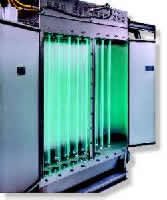
![]()
FSEC's challenge for the photoreactor design was to develop a cost-effective, energy-efficient and low-temperature process for destructive removal of volatile organic contaminants (VOCs) in air and industrial process vent gases.
After careful laboratory experiments, FSEC's researchers developed and tested a new photocatalytic oxidation process that employed a unique reactor design and titania-based photocatalytic cartridge activated by ultraviolet (UV) radiation.
Technology Description:
The advantage of FSEC's photoreactor is that it continuously generates the needed oxidants, insitu, requiring only electricity and no added consumable chemicals. Its unique features are:
Single-Pass Flow - Due to cost and performance considerations, most detoxification processes require multi-pass and continuous flow of the contaminant stream. Conventional single-pass photoreactors are not able to effectively utilize UV photons, especially when very high destruction and removal efficiencies (DREs) are required. The FSEC photoreactors employ a unique multistage catalytic media that overcomes this limitation.
Uniform Photocatalyst Activation - FSEC photoreactors employ low-cost and highly efficient low-pressure mercury lamps (LPMLs) as the UV light source. The unique design and minimal light-blocking objects within FSEC's photocatalytic cartridges result in a uniform catalyst surface irradiance that maximizes concentration of active surface species and the photoprocess efficiency.
Mass Transfer Characteristics - There are no mass transfer limitations for species transport to and from the photocatalytic surfaces. Pollutants are forced to pass through the catalytic media, resulting in an intimate contact between the irradiated photocatalyst and the target contaminants.
Decoupled Photoreactor Design - FSEC photoreactors employ a unique multi-stage design that boosts the reactor performance by partially decoupling the process photoefficiency from the DRE of the target contaminants. This revolutionary design concept allows FSEC photoreactors to achieve single-pass DREs of 99+% for most VOCs at residence times of only a fraction of a second.
Technology Cost and Applications:
 |
| Interior of 650 SCFM reactor showing low-pressure mercury vapor lamps. (Photo: S. Spencer) |
|---|
FSEC's photoprocess employs inexpensive, off-the-shelf components and is specially designed to minimize installation and operating costs. The expendable items include LPMLs and photocatalytic cartridges. Typical costs and lifetime of a standard LPML are $45 and 8,000 hours. The design of the photocatalytic media is simple and lends itself to low-cost mass production with an estimated cost of $5-10 for single-stage and $15-35 for multi-stage cartridges.
FSEC's photoreactor can be readily utilized in two broad environmental/industrial market areas: remediation of VOCs extracted from contaminated soils and ground water, and treatment of industrial process vent gases. Cost comparisons between the FSEC process and two established technologies (carbon adsorption and catalytic incineration) are given in Tables 1 and 2. In both cases, minimum required DRE is 95%, and no carbon disposal costs are assumed.
Table 1. Treatment costs for soil vapor extraction vent |
||
TECHNOLOGY |
CAPITAL COST |
ANNUAL OPERATING COST |
| FSEC, 4 stage | $25,000-$35,000 |
$4,000-$6,000 |
| Carbon Adsorption | $15,000-$100,000 |
$75,000-$125,000 |
| Catalytic Incineration | $75,000-$350,000 |
$10,000-$50,000 |
Table 2. Treatment costs for pharmaceutical product dryer process vent (3 ppmv nitroglycerin, 12000 ACFM air flow) |
||
TECHNOLOGY |
CAPITAL COST |
ANNUAL OPERATING COST |
| FSEC, 4 stage | $150,000-$250,000 |
$40,000-$50,000 |
| Carbon Adsorption | $100,000-$350,000 |
$125,000-$150,000 |
| Catalytic Incineration | $200,000-$450,000 |
$80,000-$180,000 |
For Additional Information Contact:
Dr. Ali T-Raissi, Director, Hydrogen R&D Division
Click here to contact
Florida Solar Energy Center
1679 Clearlake Road
Cocoa, Florida 32922-5703
321-638-1446
